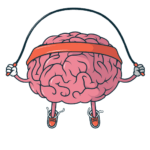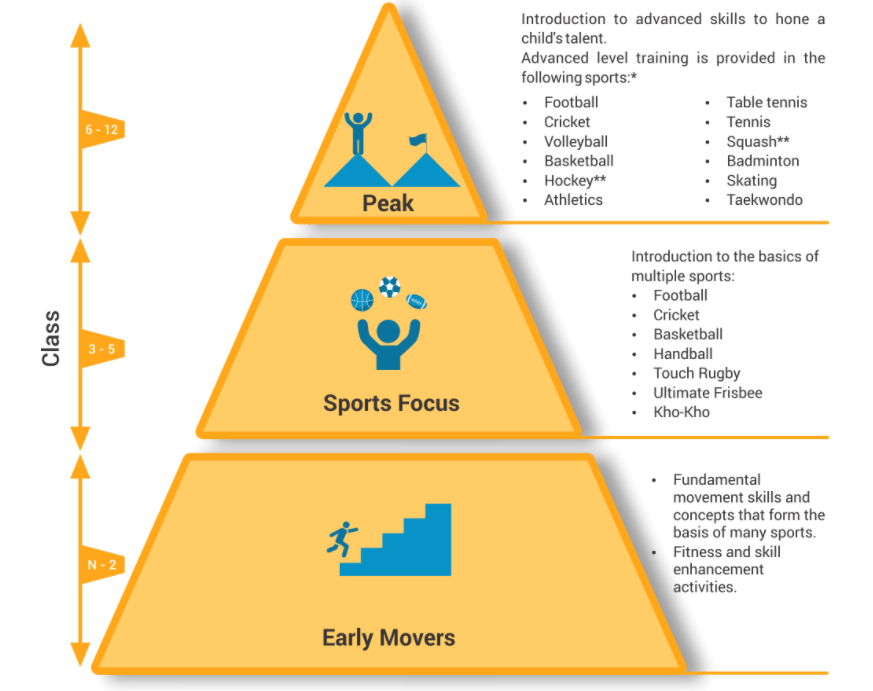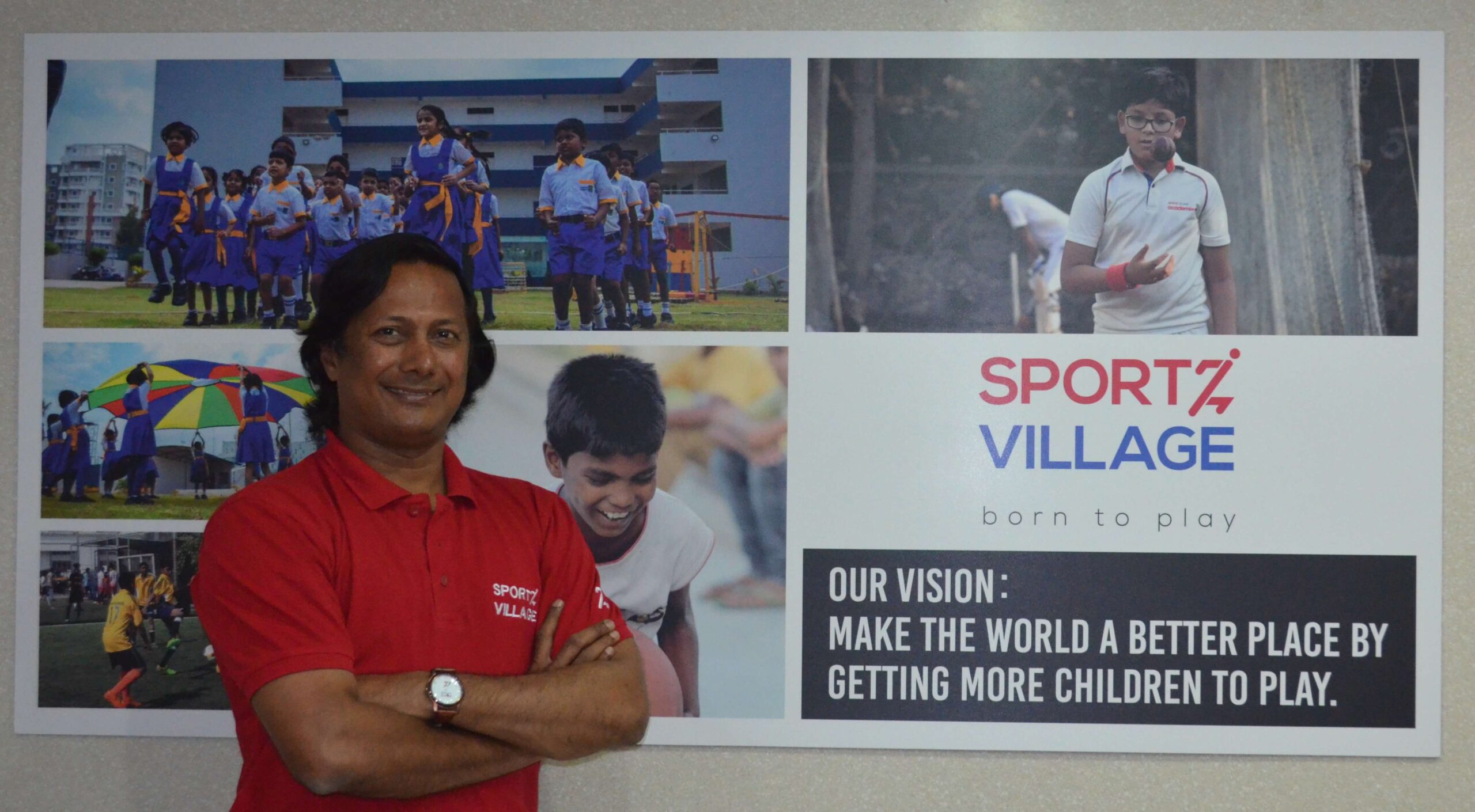Trying to get 100 million kids to play
Saumil Majmudar’s Twitter bio encapsulates his straightforward yet revolutionary ambition. The Co-Founder and Managing Director of Sportz Village, India’s leading Youth Sports Platform, believes that sports and play can solve all the worlds’ problems. As a core committee member of the Confederation of Indian Industry (CII), Saumil is working towards an inclusive and fun-based approach to sports at forums involving school boards, parent forums, federations, brands, ministries, and regulatory bodies.  He also received the CII Emerging Entrepreneur Award and has been recognized as one of the “Top 50 Leaders influencing Education” by the Education World.
He also received the CII Emerging Entrepreneur Award and has been recognized as one of the “Top 50 Leaders influencing Education” by the Education World.
Saumil lives in Bengaluru with his wife who he has known since school. Together, they have two teenage children, but folks joke that Saumil in fact has three — with Sportz Village completing 17 years in 2020.
Vijay Krishnamurthy (VK), a sports research scholar (PhD) from the University of Mysore, caught up with Saumil Majmudar (SM) for his take on the National Education Policy 2020, and the role played by sport, play and physical activity as a crucial tool for imparting 21st Century skills to Indian students.
VK: The NEP 2020 refers to “play-based learning” methods throughout the policy document, with emphasis at every stage of a child’s cognitive and non-cognitive skill development. From the perspective of implementing such a philosophy, what do you envision for sport and play at schools?
SM: Let us first look at how play-based-learning has evolved. It can be classified as ‘learning of play’ or ‘learning through play’. The former is a direct inclusion in a student’s life via the Physical Education (P.E.) period in their time-table. The NEP is referring to learning through play with ‘play-based learning’.
Although I consider it to be an ambitious goal by the Ministry [of Education], this is a genuine opportunity to engage a child in a creative manner by introducing ‘play’ concepts in core academic subjects. For example, can we teach concepts in arithmetic or trigonometry using a game of cricket? We sure can.
We have to understand that the playground is not only a place to learn new concepts in a sports context. A child’s education is a combination of physical, mental, and socio-emotional learning, especially during their formative years. In a way, the NEP is nudging educators to re-design the academic curriculum and move towards a holistic approach from the existing rote-memory way of teaching-learning.
VK: The NEP mentions no hard separation between STEM and Sport, hence breaking the barriers of extracurricular or co-curricular terms. What challenges do you foresee on blurring the lines between core subjects taught in classrooms and sport that is playground-based?
SM: At the outset, it is a welcome step by the Kasturirangan Committee to envision sports, arts, and other activities on par with academic subjects. Over the years, a deep-rooted stigma has set into our society where we rank one discipline above the other for various socio-economic reasons. Have you ever wondered why a P.E. teacher is sometimes looked down upon in comparison to a Mathematics or Science teacher within a school campus? This happens despite there being sufficient global literature that has found a positive correlation between physical fitness and academic success.
It has been observed that Structured physical activity or play improves the cognitive competence of children. It also directly improves the emotional commitment to learning which is necessary to engage meaningfully with any learning content. pic.twitter.com/TbzwU7D76L
— Sportz Village Schools (@SV_Schools) October 6, 2020
At Sportz Village Foundation, we work with CSR donors towards integrating Play & Sports into education curricula of government-school children across India. Over two decades of work in the space has shown us that implementing a structured sports curriculum can lead to significant changes in a child’s behaviour, their attention span, and peer relationships.
The key challenge here is to create a structured curriculum with detailed lesson plans for each grade as per their age-group and train the faculty to teach in an engaging manner. Once the child is involved and connected with such a program, we can push the boundaries by positively challenging them to achieve the desired learning outcomes.
VK: From a curriculum and assessment standpoint, how can various sports programs (In-school, After-school, and High-performance) be implemented and evaluated such that standard metrics are made available periodically to the school authorities?
SM: Each of the programs you mention — In-School, After-School, and High-Performance — are distinct. At the base of the pyramid is the In-School program, which is purely targeted at the grassroots. It ought to be measured on a ‘Sport for All’ metric where no child is left behind. Our physical education curriculum and assessments have to be scientifically designed so that the entire cohort of students learn the fundamentals (motor skills, agility, balance, and coordination) in their nursery and primary stages. When this happens, children fall in love with Play and will ‘Play for Life’, which directly corresponds with health, socio-emotional and community benefits.
With sound basics in place, we can bring in the next building block, which is the After-School program. This is essentially about playing organized sports like basketball, cricket, football, and being ‘coached’. At the institutional level, it is crucial to understand the difference between a P.E. Teacher and a Sports Coach since once is a generalist while the other is a specialist. After-school training modules usually include talent identification and nurturing which caters to a smaller segment of the student population.
Finally, by adopting Long-Term Athlete Development (LTAD) models, we can map the After-School programs into ‘Learn to Train’ and ‘Train to Train’ stages. The high-performance program is at the apex of this pyramid, where all dimensions needed for athletes such as fitness, nutrition, and mental coaching are made available in order for them to succeed at state and national competitions.

Given that the NEP has classified learning stages into nursery, primary, secondary, and higher secondary categories, it is possible to model a sports pyramid around the In-School, After-School, and High-Performance. The in-school program is within the ambit of the 2020 NEP and therefore has to focus on sports as an integral part of education.
VK: The 2018 Annual Status of Education Report (ASER) covered 596 districts of rural India and found that only 5.8 per cent of the schools had a P.E teacher on campus. Given that resources such as teacher capacity and a lack of infrastructure are commonly-touted excuses by administrators, how can the NEP’s guidelines for play be implemented in rural and urban schools?
SM: It is a given that infrastructure and coaches are a must-have, without which it is hard to imagine the delivery of sports education at scale. In my experience, I have observed that, on average, government schools have more open spaces as compared to private ones. So, if the playgrounds are maintained better, the In-School program’s feasibility should not be an issue, as we [at Sportz Village] have seen in our partnerships with government schools. As for teaching the building blocks of play, a full-size playground is not necessary.
Regarding the dearth of P.E. teachers, we do know that every year, around 30,000 graduates emerge with B.PEd/M.PEd degrees across India. To address the shortage of staff in remote districts, teachers with the existing B.Ed degrees can be skilled with the add-on ‘PLAY’ module. Such a strategy can help build capacity to deliver the sports education module for the nursery/primary levels since it does not involve specialized sport. As for coaches for specific sporting disciplines, the national federations can assess the supply-demand in line with each district’s schools.
VK: Classroom sessions have resumed with technology, but physical education comes with its own complications during a pandemic. What innovation do you recommend for the physical and mental well-being of children during this crisis?
SM: COVID-19 has undoubtedly impacted the education sector, and different age-group students have been affected in different ways. The technology backbone was always there, but has been brought to the forefront now more than ever before. That traditional teachers have also adopted technology to keep the 2020-21 academic year running is an encouraging sign of what is possible.
With our homes becoming both the school and the playground, we designed a “Play-At-Home” module at Sportz Village to engage the children creatively. With a combination of physical fitness drills, sports-based quiz material, and videos, we managed to connect with children reasonably well. Initially, we were sceptical about having continuous internet access in Tier-2 and Tier-3 cities but found innovative solutions like P.E. teachers who were using smartphones for smaller student groups to run the sessions. Our takeaway from COVID-19 has been that children today look for deeper engagement to learn new skills, and we need to innovate and gamify our sports education modules to suit their needs.
Besides his love for play and sports, the IIT and IIM alum is an avid non-fiction reader who is “en route to 52 books a year”. With a basic mountaineering degree from the Nehru Institute of Mountaineering in Uttarkashi, Saumil says his Himalayan treks offer a quiet time to “defrag” and make sense of all the chaos and excitement that comes with building a business like Sportz Village from scratch. He hopes to split his time between mountains and beaches in the future after having taken a few ‘workations’ during the pandemic.







Really enjoyed this interview. Now is the time to meaningfully integrate sports into our curriculum and give PE the much-needed boost it needs and sports teachers and coaches the due recognition they deserve.It will also motivate more sports lovers to start coaching our young generation.I look forward to seeing this become a reality soon!